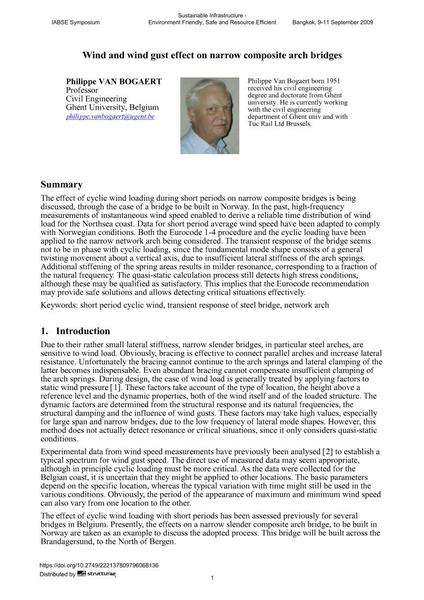Wind and wind gust effect on narrow composite arch bridges

|
|
|||||||||||
Bibliografische Angaben
| Autor(en): |
Philippe Van Bogaert
|
||||
|---|---|---|---|---|---|
| Medium: | Tagungsbeitrag | ||||
| Sprache(n): | Englisch | ||||
| Tagung: | IABSE Symposium: Sustainable Infrastructure - Environment Friendly, Safe and Resource Efficient, Bangkok, Thailand, 9-11 September 2009 | ||||
| Veröffentlicht in: | IABSE Symposium Bangkok 2009 | ||||
|
|||||
| Seite(n): | 33-41 | ||||
| Anzahl der Seiten (im PDF): | 7 | ||||
| Jahr: | 2009 | ||||
| DOI: | 10.2749/222137809796068136 | ||||
| Abstrakt: |
The effect of cyclic wind loading during short periods on narrow composite bridges is being discussed, through the case of a bridge to be built in Norway. In the past, high-frequency measurements of instantaneous wind speed enabled to derive a reliable time distribution of wind load for the Northsea coast. Data for short period average wind speed have been adapted to comply with Norwegian conditions. Both the Eurocode 1-4 procedure and the cyclic loading have been applied to the narrow network arch being considered. The transient response of the bridge seems not to be in phase with cyclic loading, since the fundamental mode shape consists of a general twisting movement about a vertical axis, due to insufficient lateral stiffness of the arch springs. Additional stiffening of the spring areas results in milder resonance, corresponding to a fraction of the natural frequency. The quasi-static calculation process still detects high stress conditions, although these may be qualified as satisfactory. This implies that the Eurocode recommendation may provide safe solutions and allows detecting critical situations effectively. |
||||
| Stichwörter: |
Netzwerkbogen
|
||||
